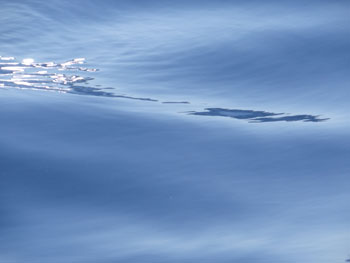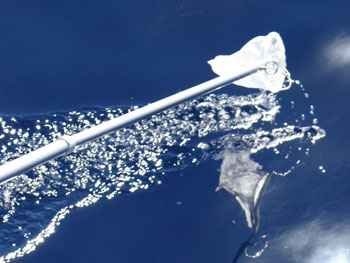Speeding back to the Deepwater Horizon: Investigating new sheens of oil two years after the Macondo well was capped
By Dr. Chris Reddy, Woods Hole Oceeanographic Institution
 Chris Reddy |
October 21, 2012 -- Science often moves slowly. But not this time.
Sheens of oil had been spotted on the Gulf of Mexico near the site of the Deepwater Horizon disaster, more than two years after the deep-sea Macondo well had released 160 million gallons of crude oil. I had heard rumors about sheens for months, but I had discounted them as likely resulting from one of many natural oil seeps scattered across the seafloor of the Gulf. BP had “shut in” the well and had inspected it with a remotely operated underwater vehicle with no signs of leaking.
But this time, oil from the sheens appeared to be from Macondo.
|
|
My colleague, Ian MacDonald at Florida State University (a member of two consortia -- Deep-C and ECOGIG -- studying the impact of the oil spill on the Gulf of Mexico and an expert on natural oil seeps) had called me to tell he thought that some newly observed sheens were likely from the Macondo well. That was Wednesday, October 10, and I was standing in a supermarket on the island of Kauai. Some of my contacts in the federal government, as well as emerging news stories, confirmed his suspicions.
BP reported that the oil sheens contained “drilling mud” and the oil was likely from the riser pipe that had once been tethered between the Deepwater Horizon platform to the Macondo well. Drilling mud is not ordinary mud, but rather a term describing a mixture of hydrocarbons and heavy minerals used during drilling operations. It also has powerful forensic value, as it is not present in the oil reservoir itself.
Finding drilling mud in the sheen suggested that the sheens originated from the drilling operations or operations to stop the leak — not from the Macondo reservoir itself. The new sheens likely came from wreckage at the seafloor, which could contain only small amounts of oil. This was relatively good news.
But researchers at the Marine Safety Laboratory at the United States Coast Guard argued that new samples of oil from the sheen did not contain drilling mud. With this discrepancy, my interest was piqued.
I happen to hold a patent for a highly sensitive and accurate method to analyze drilling mud in oil, and I wanted to determine conclusively if the reported sheens did in fact contain drilling mud. Back in my lab at the Woods Hole Oceanographic Institution in Massachusetts on October 13, I began planning to return to the Deepwater Horizon site.
I had a problem. How would I get there?
I had asked my contacts in the Coast Guard and the National Oceanic and Atmospheric Administration, but these agencies were not currently collecting samples. A BP vessel was on site, but logistical problems prevented me from getting to it. My colleague Ian MacDonald had the only planned academic research expedition to the area, but it was not scheduled until November.
I started looking for fishing boats that make one-day offshore trips. Of course, I would have to pay for the ride, and the boats I found were docked at least 100 miles away from the site. Had we hired these boats to get back and forth to the site, it would leave only an hour to collect samples. My colleague Dave Valentine at the University of California Santa Barbara, who planned to join me, wasn’t any luckier in finding a boat.
On Tuesday night, October 16, I was talking about the spill to a friend of a friend who lives in New Orleans and lamenting to him about my boat problem. He said he could get a ride for me — for free and in a boat that could go at least 60 miles an hour. Wow!
|
|
The next day, my lab assistant Bob Nelson and I had bought tickets to arrive on Friday. Valentine sent one of his postdoctoral scientists, Mattias Kellermann on Thursday to supply advance ground support.
Valentine rendezvoused with us at 3 p.m. Friday, but by then, the story on the sheens had changed. The well was not leaking. BP had confirmed with underwater video taken by a deep-sea robot, and the Coast Guard agreed, that a cofferdam (a piece of containment equipment that had been used in May 2010 to cover the gushing well) was leaking a small amount of oil. This device, which was the size of a small two-story building, had clogged, leaving a pool of oil trapped inside. Apparently, the device had just been discarded, oil and all, and was now leaking.
Already in New Orleans, Valentine and I tweaked our scientific plans. The containment efforts left us with an excellent experiment: While this oil was trapped at the cold ocean floor, did marine microbes decompose it? Valentine had come equipped to sample bacteria, so we decided to see if we could find chemical and microbiological evidence in the surface slicks of microbial degradation under deep-sea conditions.
At the crack of dawn on Saturday, we drove to the port of Venice on the Mississippi River and met up with our new research vessel. All of us had had experience doing coastal and offshore research, but this boat was quite a surprise. It was an unnamed 36-foot rocket with three 300-horsepower outboard motors and was open to the elements except for a windshield for the captain. Until then, I had thought my new friend’s claim of 60 mph was an exaggeration.
By 9 a.m., we had reached the last stretches of the Mississippi River before entering the Gulf of Mexico. The captain wasted no time in getting us to our research site near the Deepwater Horizon site. Usually that would take 12 hours at 10 miles per hour for a vessel from the academic fleet. Using a handheld GPS, we had calculated that within a few minutes on the river, we were moving more than 60 mph. It was a new experience.
|
|
We slowed down a bit once we reached the ocean, only 40 miles hour, and reached our first research site one kilometer north of the Macondo Well. After two hours, it was a relief to slow down.
Unfortunately, we first could not find any sheen. The seas were a bit choppy and the sun was too high in the sky. Moving in a circle around the location, we finally found (and smelled) the sheens. Compared to what I saw in June 2012 when the oil was stilling flowing and thick slicks of oil were floating, this oil was a light coating of oil. Hence, why we called them sheens.
With sheens to sample, we moved fast, not wanting to push the generosity of our free ride. Using a telescoping pool rod, Nelson passed a super-clean piece of Teflon netting through the sheens, as if he were removing leaves from a pool. Valentine and I had our hands full documenting the research and labeling our sample containers. Kellermann was responsible for tracking our sampling coordinates and working with the boat captain.
Hours later, we had collected eight samples and were headed home. Worn out from the ride to the site and the fieldwork, I dreaded the ride home. Two hours at 40 or more mph is taxing. Bang, slam — your body rattles every time you hit a big wave. But we got to port, exhilarated from getting samples so fast.
We have lots of work to do with those samples and will be sharing them with our Deep-C colleagues Ryan Rodgers and Alan Marshall at Florida State. But the analyses will take a little bit longer than it did to plan and execute this expedition.
Dr. Chris Reddy is a senior scientist in the Woods Hole Oceanographic Institution's (WHOI) Department of marine chemistry and geochemistry. Since April 2010, he has devoted most of his research efforts to studying the Deepwater Horizon oil spill in the Gulf. He has studied numerous other oil spills including oil leaking from a Japanese warship sunk in 1945. WHOI is a private, independent, non-profit organization in Falmouth, Mass., dedicated to marine research, engineering, and higher education. Established in 1930 on a recommendation from the National Academy of Sciences, its primary mission is to understand the ocean and its interaction with the Earth as a whole, and to communicate a basic understanding of the ocean's role in the changing global environment.
Dr. Ian MacDonald is a professor at the Florida State University (FSU). He is an oceanographer of deep-ocean extreme communities. The physical settings include natural hydrocarbon seeps, gas hydrates, and mud volcano systems. Research conducted at FSU first provided realistic numbers of spilled oil, correcting estimates published by BP. FSU has also lead investigations on the influence of oil buried in Florida beaches on microbial community composition and the fate of embedded tar mats. Focus areas extend from marine ecology, fisheries, ocean modeling, winds, remote sensing and meteorology to economics, tourism and risk assessment and remediation.
The Deep-C (Deep Sea to Coast Connectivity in the Eastern Gulf of Mexico) Consortium is a long-term, interdisciplinary study of deep sea to coast connectivity in the northeastern Gulf of Mexico. The study is investigating the environmental consequences of petroleum hydrocarbon release in the deep Gulf on living marine resources and ecosystem health. Deep-C research is made possible by a grant from BP/The Gulf of Mexico Research Initiative.
ECOGIG (Ecosystem Impacts of Oil and Gas Inputs to the Gulf) Consortium brings together physical oceanographers, marine biologists, and chemists from 14 research institutions in a holistic effort to understand the impacts of natural seepage versus that of abrupt, large hydrocarbon inputs on coupled benthic-pelagic processes in deepwater ecosystems in the Gulf of Mexico, and to chart the long-term effects and mechanisms of ecosystem recovery from the Macondo Blowout.
Deep-C was a four-year, interdisciplinary study of deep sea to coast connectivity in the northeastern Gulf of Mexico.Deep-C is no longer an active research project. The information on this website is for historical reference purposes only.
Home | About Us | Research Areas | Data Center | News & Multimedia | Education & Outreach
© Deep-C Consortium. All Rights Reserved.
This research was made possible by a grant fromThe Gulf of Mexico Research Initiative (GoMRI).
Copyright | Disclaimer | Privacy Policy

 Sheen around the Deepwater Horizon disaster on October 20, 2012. Notice that the oil has “dampened” the sea surface, smoothing its surface expression. We looked for these dampened areas rather than the actually sheens as sunlight made the sheens difficult to see at boat level. (Photo credit: C. Reddy, WHOI)
Sheen around the Deepwater Horizon disaster on October 20, 2012. Notice that the oil has “dampened” the sea surface, smoothing its surface expression. We looked for these dampened areas rather than the actually sheens as sunlight made the sheens difficult to see at boat level. (Photo credit: C. Reddy, WHOI) Bob Nelson (Woods Hole Oceanographic Institution) collecting
Bob Nelson (Woods Hole Oceanographic Institution) collecting  Telescoping pool with Teflon screen being passed through the sea surface. Note the dampened sea surface in the bottom right. (Photo credit: C. Reddy, WHOI)
Telescoping pool with Teflon screen being passed through the sea surface. Note the dampened sea surface in the bottom right. (Photo credit: C. Reddy, WHOI)